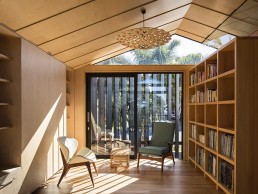
Boatshed residential, New Zealand
Strachan Group Architects has created a home that reflects the beliefs and needs of the family while referencing the boating and beach culture of the area.
Inserted onto a small and very difficult corner site, this elegant, light-filled assemblage of three boat-shed like structures is a superb response to the lives of a busy boating and sporting family. Robust yet elegant, full of surprises, and making inspired use of wood, glass and steel, the house is beautifully built throughout.
A superb, relaxed, confident family home with real personality, it makes a vivid streetscape contribution to its neighbourhood and as such has won numerous awards including the NZIA Architecture Award 2015 for housing.
SGA, in association with Rachael Rush, designed the house, which sits on a constrained, compact urban site, a stone’s throw away from Takapuna Beach. The three-stepped gables of the black ‘boatsheds’ appropriately reference the boating and beach culture of the area, with the sliding forms revealing a solution beyond the standard connotations of a home – a bespoke incubator for the clients’ lifestyle.
Along with their love of the ocean, the clients’ affinity for natural wood played a part in SGA’s inspiration for the house design. The clients share a passion for the warmth that wood contributes to a home as well as its ability to express exquisite craftsmanship.
The corner site, challenged by two 5m front yards and the blunt presence of a three-storey neighbour hard on the North-West boundary, stimulated an approach of layered complexity with ample transparency to capture light, sun and glimpses of the Pohutukawa and baiting ocean. Simplicity of the exterior form is contrasted by the highly crafted timber interior, exhibiting the skilled artistry of the builder. A diverse succession of multi-connected spaces creates a threaded flow of movement, whilst each maintains a distinct and sequestered quality.
The house opens and closes in response to shifts in weather and programme, with walls that lift, fall, slide, fold, shut down or disappear. This is a house with intent to engage the viewer, the viewed and the operator with sense and intrigue. The overall feel is consistent with a monochromatic approach to materiality, finishes, fittings and furniture, with the result enveloping and intricately detailed.
Feature lighting from David Trubridge was chosen for the house and at night the lights cast unique shadow effects across the voluminous patterned ceilings in lapped plywood.
Commenting on the importance of light in the project SGA Director Pat de Pont told darc: “A great deal of what this house is about is related to light, and particularly with transmission and transparency. The intention is to enlarge and animate space with light from the inside and to dissolve the building’s exterior to reduce its bulk and dominance on the corner site. The building is crafted like a jewellery box with a simple, recessive exterior and a warm golden glowing interior, a lantern that only really shows itself at night.”
Some of the challenges associated with this project revolved around the building’s structure. Spread over ten split levels, with a large area of either glazing or fully exposed structure, integrating services, lighting and wiring circuits was particularly complex, according to de Pont. Wiring runs for power and lighting had to be carefully planned prior to structure being put in place and the positioning of lighting controls and fittings had to be both practically functional and aesthetically seamless.
de Pont continued: “As the owners are keen and accomplished sailors they have a unique understanding of their environment, sun, moon phases, wind direction and the vagaries of weather patterns. Partly, as a reflection of this, the house is designed with an emphasis on its relationship with the outdoors and the ability to ‘tune’ the house to the exterior conditions. This principle extends to the lighting and is particularly evident in the feature light fittings, which evoke the patterns of dappled light through the trees of our coastline or the reflecting of light off rippled water.”
Concluding, de Pont said: “The lighting provides the house with the ability to transform gracefully from a light receptacle by day into a glowing lantern at night.”



